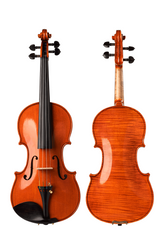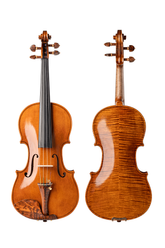What is the violin bow made of? |Fiddlover Violin Shop
Whether it is a professional player or a beginner violinist, a good bow can make them a better playing experience. Of course, like a violin, a good bow requires high-quality materials. Maybe you are confused when choosing the right bow because you don't know the material of the bow. Don't worry, after reading this article, I will introduce the materials and advantages and disadvantages of the bow in detail.
The components of a violin bow
- Bow Stick: The main part of the bow, is typically made of pernambuco wood, Brazilwood, or carbon fiber. It is a long, slender rod that provides stability and flexibility.
- Frog: Located at one end of the bow stick, the frog is usually made of ebony or another dense hardwood. It serves as the grip or handle of the bow and contains the mechanisms for tightening and loosening the bow hair.
- Screw and Eyelet: These are the components within the frog that allow for the adjustment of hair tension. The screw is turned to tighten or loosen the hair, while the eyelet holds the hair in place.
- Hair: The bow hair is traditionally made from horsehair, though synthetic alternatives are also available. The hair is attached to the frog and extends along the length of the bow stick. It is the part that makes contact with the violin strings to produce sound when the bow is drawn across them.
- Wedge and Slide: These are small components within the frog that secure the hair in place and allow for fine tension adjustments.
- Lapping: Lapping refers to wrapping or winding around the bow stick near the frog. It provides a grip and protects the stick from wear.
You can gain a detailed understanding of the structure and functioning of the violin bow through the article titled "As a violin beginner, have you really understood the violin bow?"
The material of the violin bow stick
The selection of the bow stick is a very important step in the production of the bow. A good bow stick needs to be elastic and tough, and there are clear requirements for the hardness and weight of the material. So currently there are three most common violin bows on the market: fiberglass violin bows, carbon fiber violin bows, and wooden violin bows.
Fiberglass violin bow:
Fiberglass violin bows are made of a mixture of fiberglass and plastic and are generally hollow. Generally speaking, this kind of violin bow is relatively cheap and often appears in cheap violin sets. If it is purchased separately, not recommended to buy it. Of course, if it is only due to budgetary factors, then it will have more advantages. Still, it shouldn't be too big of a budget to spend on it.
Advantage:
·Very cheap. Fiberglass raw materials are very cheap and can be mass-produced when producing bows, so the overall cost is very low.
· Not easy to break. Fiberglass is stronger, so it is stronger than traditional wooden materials.
· Not affected by temperature. Fiberglass is resistant to high temperatures and has strong stability. When used as a bow stick, it has no effect on the change of the external temperature.
· Easy to buy. There is no need to make a careful selection, just choose the appropriate size, and the performance will not make a big difference.
Shortcoming:
· Poor sound quality.
· Poor balance.
· Not suitable for higher playing skills.
The overall evaluation is low-end in the grade of bows, just the cheapest choice.
Carbon Fiber Violin Bow:
The bow stick of the carbon fiber violin bow is made of carbon fiber composite material. The characteristics of this material are wear resistance, pressure resistance, and good elasticity, which makes it naturally have the characteristics of being a bow stick. After being made into a bow by bow makers, people quickly discovered its advantages.
After replacing the traditional wooden bow, it not only has a beautiful sound, but also is stronger than the wooden bow, and it performs much better than the wooden bow in the extreme outdoor environment because it is affected The influence of outside temperature changes is very small. Many people even believe that carbon fiber violin bows will be the best choice to replace the increasingly rare Pernambuco wood violin bows in the future.
Advantage:
·Cheaper. Mass production reduces production costs.
· Beautiful voice.
·Strong and sturdy.
·Stable performance, less affected by the external environment, able to adapt to the complex playing environment.
Shortcoming:
·It has appeared for a short time, and people know less about it.
·The performance and feel are different from wooden bows. If you have used wooden bows before, you need to get used to them for a while.
· It is not clear how to make a selection.
·There are very few very high-end carbon fiber violin bows.
In the overall evaluation, the carbon fiber violin bow belongs to the middle and low grades in the bow grade, which is very suitable for violin beginners or professionals who often need to go out to play.
Wooden violin bow
Violin bows have always been made of wood. Wooden violin bows are a favorite until now. The wood used as a bow not only needs to consider the hardness of the wood but also needs to consider various factors such as the sound transmission performance and aesthetics of the wood. Therefore, although there are many types of wood in nature, the more common woods suitable for violins include brazilian wood, sandalwood, mahogany, pernambuco, snake wood, etc. The sound transmission speed of these woods is generally required to be above 5000m/s.
Advantage:
·High recognition. Well-known international competitions or professional performances will use wooden violin bows.
· Strong maneuverability. Use the wooden violin bow to play to demonstrate different techniques or play different styles of violin pieces.
·Excellent wooden violin bow has a beautiful and clear sound.
·Suitable for all violinists, the bows made of different woods and crafts have clear price distinctions, and you can choose the price that suits you according to your situation.
Shortcoming:
·Like a violin, a wooden bow is greatly affected by the environment.
·It is relatively fragile, and it is likely to break if it is accidentally dropped, especially since the tip of the bow is the most likely part of the whole bow, which requires extra protection.
·There are many types and materials, and it is easy to not know which one is more suitable for you when purchasing.
·Because the violin bow is made of wood, when traveling abroad, you should pay attention to whether the material of your bow is allowed to enter and exit. Generally speaking, only expensive violin bows need more attention.
The most expensive violin bow material - Pernambuco wood violin bow
If you're looking for the most expensive violin bows, look no further than a violin bow made from Pernambuco wood. Pernambuco wood is native to Pernambuco, Brazil. In the 16th century, Portuguese navigators discovered this tree on the east coast of South America, named it Pernambuco wood (also known as Brazilian wood at first), and brought it back to Europe. In the whole world, there are very few trees with such prestige that it has become the name of a country (Brazil) because of their name. At first, it was used as a dye, and later, with the use and admiration of French bow makers, it gradually became the best choice for making bows. However, due to centuries of excessive logging, the tree species is currently on the verge of extinction and is protected and regulated by organizations such as CITES.
Advantage:
·The sound is very beautiful.
·Beautiful appearance, clear wood grain.
· Good elasticity and toughness.
Shortcoming:
·Very expensive.
·Very rare.
·It is an endangered species and is protected by law. When entering or leaving the country, you need to understand the local laws and confirm whether they can pass.
Overall evaluation, the wooden violin bow is suitable for violinists of all stages, whether you are a beginner or a professional player, you can choose a suitable bow according to your situation. Here it is suggested that beginners can buy violin bows made of mahogany, snakewood, brazilian wood, and sandalwood, which are more suitable in terms of price and performance. But it must be noted that Brazilian wood and pernambuco wood are not the same material in the present.
Violin bow hair
Generally speaking, the bow hair of the violin is made of horsetail hair. It is also an important part of the violin bow. There is a detailed introduction in the article before, which can be viewed through our website. The article name: The most complete knowledge of violin bow hair.
Decorative accessories for the bow
The performance of the bow mainly depends on the level of craftsmanship and the matching of bow sticks and bow hair materials and has no direct relationship with the quality of other decorative items. Generally speaking, frogs are decorated with pearl shells, gold, silver, ivory, and other items to make the bow more beautiful. But these expensive decorative items cannot provide the performance of the bow, so when buying a bow, you can’t just refer to the price of the violin and think that its performance must be high. It may just have better decoration.
Round or octagonal violin bow
Most manufacturers make round bows, and very few make octagonal bows. Sometimes we also receive customers who want to buy octagonal bows, but there are more customers who want to buy round bows. So this makes octagonal bows even rarer on the market. Of the two types of bows, the octagonal bow is harder and is more suitable for violins with softer sounds.





